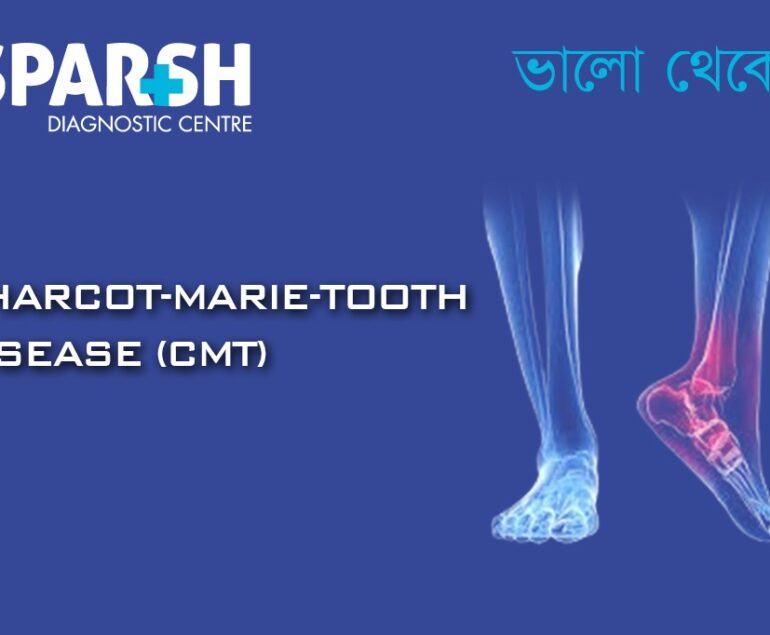Foot drop, also known as drop foot, is not a disease itself but a neurological or muscular symptom that causes difficulty in lifting the front part of the foot. This condition can significantly affect a person’s ability to walk normally and may result in tripping or dragging the foot. It’s typically a sign of an underlying neurological, muscular, or anatomical problem.
At Sparsh Diagnostic Centre, we specialize in diagnosing and managing complex neurological disorders like foot drop with advanced imaging, electrodiagnostics, and comprehensive care.
What Is Foot Drop?
Foot drop refers to the inability or difficulty in lifting the forefoot, causing it to hang down or drag while walking. People with foot drop often compensate by raising their thigh higher than normal — a walking pattern known as steppage gait.
It can affect one or both feet and may be temporary or permanent, depending on the cause.
Causes of Foot Drop
Foot drop is usually caused by nerve injury, muscle disorders, or brain/spinal cord conditions. Understanding the root cause is key to proper treatment.
1. Peroneal Nerve Injury
Most common cause.
The peroneal nerve, a branch of the sciatic nerve, controls the muscles involved in lifting the foot.
Can be injured due to:
Knee or leg surgery
Sitting cross-legged for long periods
Prolonged squatting
Trauma or fractures near the knee
2. Neurological Conditions
These conditions can affect the brain or spinal cord pathways that control leg and foot movement.
3. Muscle Disorders
Muscular disorders lead to muscle weakness, impairing the foot’s ability to lift.
4. Spinal Problems
Tumors compressing nerves in the spine
Risk Factors
You may be at increased risk of foot drop if you have:
Diabetes (can cause peripheral neuropathy)
Habitual leg crossing or prolonged kneeling
Previous surgeries involving the hip, knee, or spine
Signs and Symptoms of Foot Drop
The symptoms may develop gradually or suddenly, depending on the cause. Common signs include:
Dragging foot while walking
High-stepping gait (lifting the thigh to avoid dragging the toes)
Numbness or tingling on the top of the foot or toes
Weakness in foot or ankle
Difficulty standing on the heel
If you notice these signs, consult a medical professional immediately to avoid long-term complications.
How Is Foot Drop Diagnosed?
A thorough evaluation is crucial for identifying the underlying cause. At Sparsh Diagnostic Centre, we follow a structured approach that may include:
1. Medical History and Physical Examination
Evaluation of gait
Muscle strength testing
Reflex and sensory examination
2. Electromyography (EMG) and Nerve Conduction Studies
Measure electrical activity in muscles and nerve signals
Helps pinpoint the location and severity of nerve damage
3. Imaging Tests
MRI of the brain, spine, or leg to detect tumors, disc herniations, or nerve compressions
Ultrasound of the nerve to assess injury or entrapment
X-rays if bone injury is suspected
Treatment Options for Foot Drop
Treatment for foot drop depends on the underlying cause, severity, and whether the condition is temporary or permanent. Early diagnosis and treatment improve outcomes significantly.
1. Physical Therapy
Key for restoring mobility and strength
Includes:
Stretching exercises
Muscle strengthening
Gait training
2. Ankle-Foot Orthosis (AFO)
A supportive brace worn on the lower leg and foot
Keeps the foot in a normal position and prevents it from dragging
3. Nerve Stimulation
Functional electrical stimulation (FES) stimulates peroneal nerve during walking
Helps lift the foot and improve walking patterns
4. Medication
If caused by inflammation (e.g., due to MS or autoimmune conditions), corticosteroids or immunosuppressants may be prescribed
5. Surgical Options
In cases where foot drop is caused by structural damage or doesn’t respond to conservative treatment:
a. Nerve Decompression
If a nerve is compressed (e.g., due to a herniated disc or tumor)
b. Tendon Transfer Surgery
Involves rerouting functional tendons to replace the non-functioning ones
c. Nerve Grafting or Repair
For severe nerve injuries or severed nerves
Living with Foot Drop
Living with foot drop can be challenging, especially if it becomes a chronic condition. Supportive measures include:
Wearing proper footwear
Using assistive devices like canes or walkers
Home modifications to prevent falls
Participating in support groups or physiotherapy sessions
Prevention Tips
While not all causes of foot drop are preventable, here are some tips that may help reduce your risk:
Avoid prolonged leg crossing or squatting
Maintain proper posture during work
Control underlying health conditions like diabetes
Use protective gear while playing contact sports or during high-risk activities
Follow post-surgical rehabilitation properly
When to See a Doctor
Seek immediate medical attention if you experience:
Sudden weakness in the foot or leg
Difficulty walking or maintaining balance
Numbness or tingling in the leg or foot
Any signs of nerve injury after surgery
Delaying treatment may lead to permanent disability.
Why Choose Sparsh Diagnostic Centre for Foot Drop Evaluation?
At Sparsh Diagnostic Centre, we bring together expert neurologists, radiologists, and physiotherapists to provide comprehensive and compassionate care for patients with foot drop and other neurological conditions.
We offer:
✅ Advanced ultrasound imaging
✅ EMG & Nerve Conduction Studies
✅ Personalized physiotherapy & rehabilitation programs
✅ Guidance from certified specialists
Our goal is not just to manage symptoms, but to treat the root cause and help you regain your independence.
Foot drop is a complex condition that can impact mobility, independence, and quality of life. Early detection, accurate diagnosis, and tailored treatment are essential to prevent complications and promote recovery.
If you or someone you love is experiencing symptoms of foot drop, don’t ignore it. Visit Sparsh Diagnostic Centre for timely evaluation and holistic care.
Visit Us Today!
🕘 Mon–Sat: 7 AM – 9 PM | Sun: 7 AM – 3 PM
📞 Call: 9830117733 / 8335049501
🌐 www.sparshdiagnostica.com
#BhaloTheko
Disclaimer:
No content on this site, regardless of date, should ever be used as a substitute for direct medical advice from your doctor or other qualified clinician.

![]()






[…] Foot drop (difficulty lifting the front part of the foot) […]